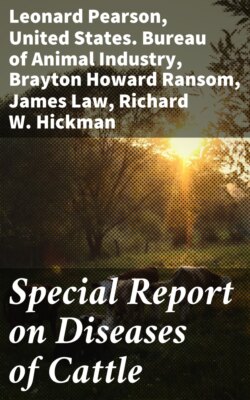Читать книгу Special Report on Diseases of Cattle - Lowe - Страница 129
На сайте Литреса книга снята с продажи.
CATARRH (COLD IN THE HEAD).
ОглавлениеNasal catarrh is an inflammation of the mucous membranes of the nostrils and upper air passages. Simple catarrh is not a serious disease in itself, but if neglected is liable to be complicated with laryngitis, bronchitis, pneumonia, plurisy, or other serious and sometimes fatal diseases of the respiratory organs. Catarrh is a common disease among cattle. It is often caused by sudden exposure to wet and cold after they have been accustomed to shelter. It may arise from inhalation of irritating gases. It is also sometimes produced by certain specific atmospheric conditions, and may assume an enzoötic form. It is very debilitating, and requires prompt and judicious treatment.
Symptoms.—Redness of the mucous membranes of the nose and redness and watering of the eyes are symptoms of nasal catarrh. The mucous membrane first becomes dry; afterwards a watery discharge appears, and later, in severe cases, the discharge becomes mucopurulent. In mild cases there is little or no fever, but in severe ones it may run high. The animal becomes dull, languid, and is not inclined to move about, and the appetite may become impaired; there is also variable temperature of the horns and ears. If in a cow giving milk the secretion diminishes, the mucus from the eyes and nose becomes thicker and yellower. Afterwards, as the symptoms increase in severity, the discharge becomes mucopurulent.
Treatment.—The animal should be housed in a well-ventilated place, with good hygienic surroundings. In cold and damp weather it should be kept warm with blanketing, and, in severe cases, hot, medicated inhalations given. If the fever is high, it may be reduced by giving nitrate of potassium, from 1 to 2 ounces, in the drinking water, three times daily. Diffusible stimulants are beneficial in most cases. Too much importance can not be attached to good nursing. There is no necessity to resort to the old system of bleeding, purging, or the use of powerful sedatives.
